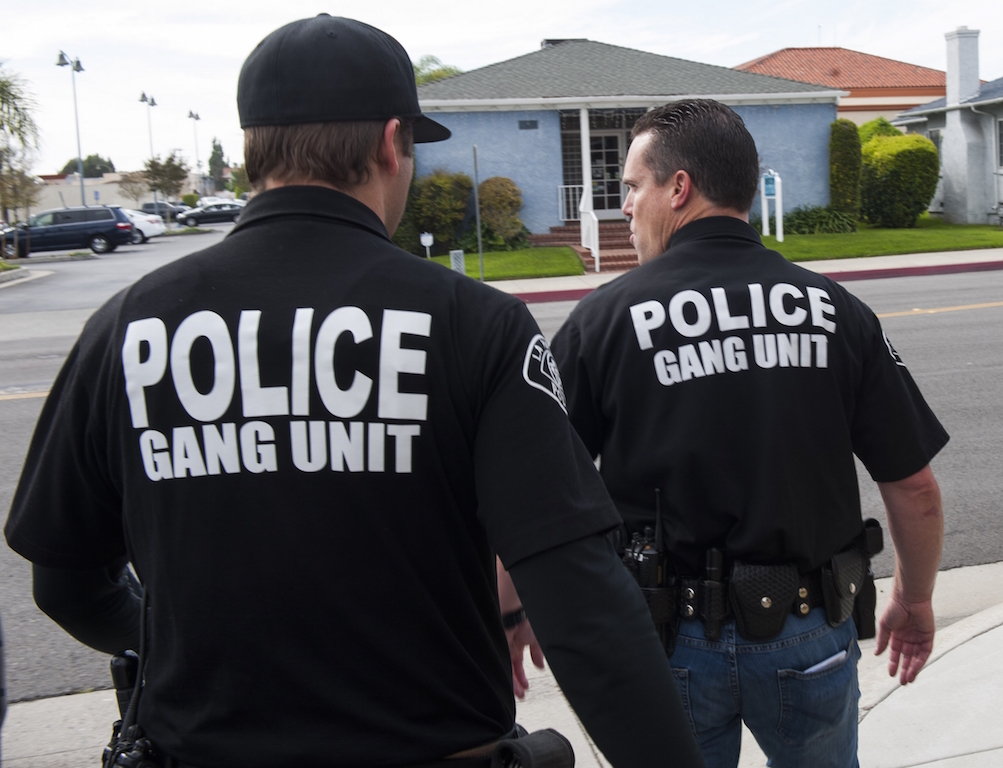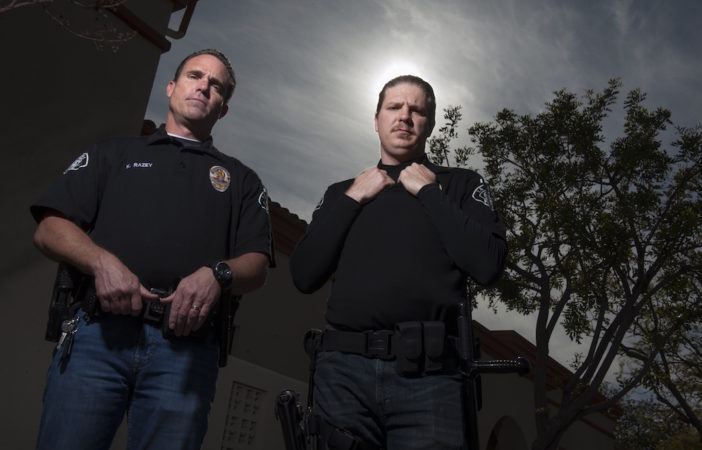The teen sat relaxed on the curb, leaning back onto his hands with his feet outstretched in the street.
The two La Habra gang unit detectives were equally as relaxed.
There was laughing, pleasantries and even talk about the best side dishes to bring to a weekend barbecue.
“Wait, I know you,” Det. Daniels concluded after some small talk.
He and Det. Razey knew who the 17-year-old was when they stopped him for riding his bicycle without lights on a recent Friday night.
“Your cousin runs with one of our La Habra gangs,” Daniels said, maintaining the light mood.
Through a smirk, the teen denied knowing anything about that, but the detectives pushed on.
“Yeah, he does. That’s right,” Daniels said snapping his fingers.
The detectives pointed out the teen’s Washington Nationals hat, explaining it’s common for gang members and their affiliates to wear sports gear to represent their crew.
“It’s just a hat,” the teen said. “I like the team.”
Razey jumped in.
“Oh, really? Cool. Can you name four players?”
The teen couldn’t name one.
The detectives took the opportunity to let the high school student know that they know who he’s been running with and offered a warning.
“Just remember, there are repercussions for what you do,” Razey said. “It’s something you have to think about: Do you want to do this the rest of your life?
“Just know, what we don’t find out now, we’ll find out later.”
The entire interaction was pleasant, friendly even — one of the tactics of La Habra’s newest gang unit.
“You always catch more flies with honey,” Daniels said. “You can always bring (your intensity) up, if you need to and sometimes, with some of these guys, you have to.”

Gang detectives Daniels and Razey patrol city streets every weekend looking for suspicious gang activity. Photo by Miguel Vasconcellos/Behind the Badge OC
Working in the gang unit starts with talking, lots of tracking and gathering intel, and keeping your finger on the pulse of the city’s gangs to ensure the historic low in gang-related activity the department has realized in recent years stays that way.
From the early 1990s to about 2005, La Habra had a serious gang problem.
It seemed every year the city was dealing with gang-related homicides, along with multiple non-fatal shootings, stabbings and drive-bys.
In a city with nearly 62,000 residents, the activity was considered significant.
School resource officers and a full-time probation officer were introduced in the department, and La Habra PD later changed the way officers policed the streets.
The changes worked. Using crime data for predictive policing and patrolling the city based on crime districts,contributed to city seeing a 25-year low in its crime rates, in 2014.
However, police must remain diligent and proactive to keep the city from slipping back to the days when gang violence was considered a normal dynamic in many La Habra neighborhoods.
Razey, a 15-year veteran of the La Habra PD, has been with the unit about a year. Daniels, who has four years on the force, started with the unit in September.
Razey, who worked as a motor officer for nine years, never thought he’d be chasing after gang members, while Daniels knew he wanted to land this assignment when his badge was first pinned.
They make a good team.
“He’s a wealth of knowledge,” Daniels said of Razey. “Our partnership works well because it’s a melding of different expertise.”
Daniels takes pride in being the stats guy — expertly logging information on gang affiliates and learning to spot trends — while Razey serves as the seasoned mentor who is good with the advice.

Detectives Razey, left, and Daniels, right, are members of the La Habra PD Gang Unit. Photo by Miguel Vasconcellos/Behind the Badge OC.
The duo typically works nights and when not running parole checks or visiting recently released documented gang members, they run suppression operations.
Part of that suppression effort means looking to prevent kids from joining gangs in the first place.
If a La Habra School Resource Officer reports an at-risk student is having problems in school, Razey and Daniels will step in and try to mentor the student and encourage them to choose a different life path.
“By high school, most kids have made the decision (whether or not they will join a gang),” Daniels said. “We go out and talk to middle school kids and let them know we’re not the bad guys, and really try to get them focused on the right path, so they don’t have issues down the road.”
The police are looking at introducing programs, such as the Orange County District Attorney’s Gang Reduction Intervention Program (GRIP), as an added resource to deter kids from gangs.
“Middle schoolers are where we need to put our focus because they are the most easily influenced,” Razey said.
The hard part, he added, is reaching the children born into families where gang life has become a tradition.
“We have families here who are fourth or fifth generation gang members who grew up in this town,” Razey said.
This dynamic calls for a different kind of suppression technique.
“Our suppression usually involves going to targeted gang neighborhoods or neighborhoods we have identified as areas where, historically, gangs hang out,” Daniels said. “We like to keep our presence there.”
The gang unit cruises around in an unmarked SUV — a vehicle that’s supposed to be discreet, but Razey said it’s well-known in the city.
“As soon as they see the SUV coming, they know,” he said. “They know exactly what it is and who we are.”
That presence is what Razey and Daniels said helps deter gang activity.
“Just seeing us can keep gang members at bay,” Daniels said. “We’re definitely a proactive unit, that’s why I love our job.”
Although not every contact ends with an arrest, each interaction is working toward an ultimate end goal: keeping La Habra’s neighborhoods safe.
“It’s a big cat and mouse game but, at the end of the day, we’re going to win,” Razey said.
 Behind the Badge
Behind the Badge



